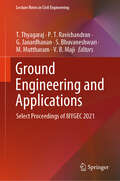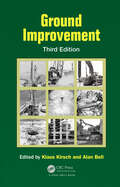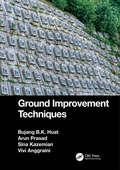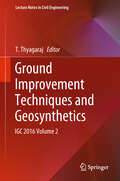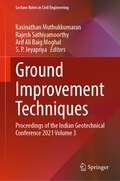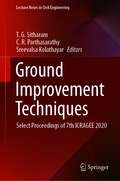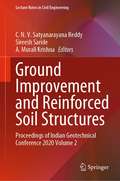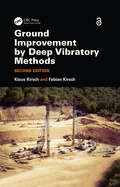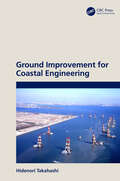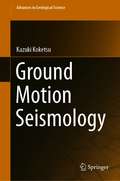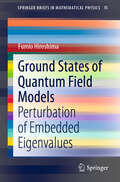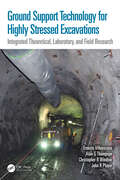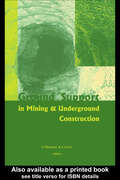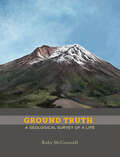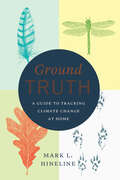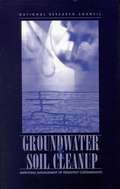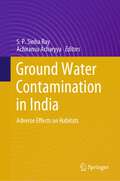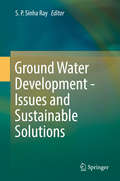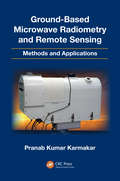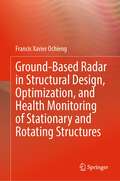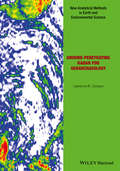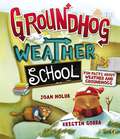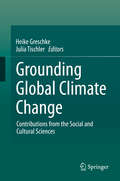- Table View
- List View
Ground Engineering and Applications: Select Proceedings of 8IYGEC 2021 (Lecture Notes in Civil Engineering #429)
by V. B. Maji M. Muttharam T. Thyagaraj P. T. Ravichandran G. Janardhanan S. BhuvaneshwariThis volume presents the select proceedings of the 8th Indian Young Geotechnical Engineers Conference (8IYGEC 2021) on the following conference themes: Ground Improvement and Transportation Geotechnics. The papers in this volume cover a wide range of topics on ground improvement which include the modification using different synthetic and natural materials and inclusions in the form of fibers, geotextiles, geogrids, prefabricated vertical drains and soil nails in different ground improvement applications, and chemical modification of problematic soils using both natural additives and industrial by-products such as lime, cement, calcium chloride, calcium carbide, lignosulphonate, fly ash, blast furnace slag and bioenzymes, treatment of expansive soils with granular piles, vibro-compaction, etc. Further, this volume covers the various aspects of transportation geotechnics related to the static and dynamic performance of pavements reinforced with geosynthetic materials, drainage characteristics, and the use of marginal materials in pavements, etc. The book can be a valuable reference for researchers and professionals.
Ground Improvement
by Alan Bell Klaus KirschWhen finding another location, redesigning a structure, or removing troublesome ground at a project site are not practical options, prevailing ground conditions must be addressed. Improving the ground modifying its existing physical properties to enable effective, economic, and safe construction to achieve appropriate engineering performance is an
Ground Improvement Techniques
by Bujang B.K. Huat Arun Prasad Sina Kazemian Vivi AnggrainiThis book provides a review of problems during design and construction on problematic soils. Design methods, site investigation, construction and analysis of the various improvement methods available are explained and discussed. Various regions may have different soils with geotechnical problems that differ from those faced in other regions. For example, in Southeast Asia, the common geotechnical problems are those associated with construction on soft clays and organic soils, while in the arid region of the Middle East, problems are generally associated with the desert soils. In the US, the problems are associated with organic soils, expansive and collapsing soils, and shale. Laterite and lateritic soils are especially problematic in Mexico. Similarly, in Europe, for example, the geotechnical problems are associated with loess (France), and organic soil (Germany). A detailed description of various methods of ground improvement has been provided in 11 chapters. Each chapter deals not only with a description of the method but also focuses on region-specific ground problems and suitable ground improvement techniques. Case studies have also been included. One general chapter is dedicated to site investigation, instrumentation, assessment and control. This book will be of value to students and professionals in the fields of civil and geotechnical engineering, as well as to soil scientists and engineering geologists.
Ground Improvement Techniques and Geosynthetics: Igc 2016 Volume 2 (Lecture Notes in Civil Engineering #14)
by T ThyagarajThe book comprises select proceedings of the 2016 annual conference of the Indian Geotechnical Society (IGC 2016), with technical papers on the theme “Ground Improvement and Geosynthetics”. The papers cover a wide range of topics, including chemical modification using admixtures, microbial-induced carbonate precipitation, geopolymers, fly ash and other industrial wastes, modification using geosynthetic materials such as natural and synthetic fibers, expanded polystyrene (EPS) geofoam, prefabricated vertical drains, geosynthetic encased-granular columns and mechanical densification through sand columns. This book is a valuable reference for researchers and practicing engineers alike.
Ground Improvement Techniques: Proceedings of the Indian Geotechnical Conference 2021 Volume 3 (Lecture Notes in Civil Engineering #297)
by Arif Ali Baig Moghal Kasinathan Muthukkumaran Rajesh Sathiyamoorthy S. P. JeyapriyaThis book comprises the select peer-reviewed proceedings of the Indian Geotechnical Conference (IGC) 2021. The contents focus on Geotechnics for Infrastructure Development and Innovative Applications. The book covers topics related to ground improvement techniques, like stone columns, PVD, granular pile anchors, soil stabilization methods, like fly ash & chemicals, effect of biopolymer inclusion, innovative material for soil and ground improvement, among others. This volume will be of interest to those in academia and industry.
Ground Improvement Techniques: Select Proceedings of 7th ICRAGEE 2020 (Lecture Notes in Civil Engineering #118)
by T. G. Sitharam Sreevalsa Kolathayar C. R. ParthasarathyThis volume presents select papers presented at the 7th International Conference on Recent Advances in Geotechnical Earthquake Engineering and Soil Dynamics. The papers discuss advances in the fields of soil dynamics and geotechnical earthquake engineering. Some of the themes include slope stability, shallow and deep foundations, geosynthetics, ground improvement techniques, etc. A strong emphasis is placed on connecting academic research and field practice, with many examples, case studies, best practices, and discussions on performance based design. This volume will be of interest to researchers and practicing engineers alike.
Ground Improvement and Reinforced Soil Structures: Proceedings of Indian Geotechnical Conference 2020 Volume 2 (Lecture Notes in Civil Engineering #152)
by Sireesh Saride A. Murali Krishna C. N. V. Satyanarayana ReddyThis volume comprises the select proceedings of the Indian Geotechnical Conference (IGC) 2020. The contents focus on recent developments in geotechnical engineering for sustainable tomorrow. The volume covers the topics related advances in ground improvement of weak foundation soils for various civil engineering projects and design/construction of reinforced soil structures with different fill materials using synthetic and natural reinforcements in different forms.
Ground Improvement by Deep Vibratory Methods
by Klaus Kirsch Fabian KirschVibro compaction and vibro stone columns are the two dynamic methods of soil improvement most commonly used worldwide. These methods have been developed over almost eighty years and are now of unrivalled importance as modern foundation measures. Vibro compaction works on granular soils by densification, and vibro stone columns are used to displace and reinforce fine-grained and cohesive soils by introducing inert material. This second edition includes also a chapter on vibro concrete columns constructed with almost identical depth vibrators. These small diameter concrete piles are increasingly used as ground improvement methods for moderately loaded large spread foundations, although the original soil characteristics are only marginally improved. This practical guide for professional geotechnical engineers and graduate students systematically covers the theoretical basis and design principles behind the methods, the equipment used during their execution, and state of the art procedures for quality assurance and data acquisition. All the chapters are updated in line with recent developments and improvements in the methods and equipment. Fresh case studies from around the world illustrate the wide range of possible applications. The book concludes with variations to methods, evaluates the economic and environmental benefits of the methods, and gives contractual guidance. The Open Access version of this book, available at http://www.taylorfrancis.com, has been made available under a Creative Commons Attribution-Non Commercial-No Derivatives 4.0 license
Ground Improvement for Coastal Engineering
by Hidenori TakahashiThis practical guide covers the investigation, design, and execution of ground improvement in coastal areas. It explains how to decide whether ground improvement is necessary, which method to choose, and how to design and execute it. Recognising the soft ground commonly found in coastal areas, the book introduces various ground improvement technologies including seismic reinforcement and liquefaction countermeasures and addresses the measures to be taken to sustain ground against external forces. Reliable Japanese ground improvement technologies are presented as well as the latest Building Information Modelling (BIM/Information and Communication Technology (ICT) used in their execution. The book also includes measures that can be taken against contaminated soil and considers ground improvement design on site. Unique focus on coastal applications Summarises leading edge Japanese practice The book suits professionals in the ground improvement industry, especially geotechnical designers and contractors.
Ground Motion Seismology (Advances in Geological Science)
by Kazuki KoketsuThis book explains the physics behind seismic ground motions and seismic waves to graduate and upper undergraduate students as well as to professionals. Both seismic ground motions and seismic waves are terms for “shaking” due to earthquakes, but it is common that shaking in the near-field of an earthquake source is called seismic ground motion and in the far-field is called seismic waves. Seismic ground motion is often described by the tensor formula based on the representation theorem, but in this book explicit formulation is emphasized beginning with Augustus Edward Hough Love (1863 – 1940). The book also explains in depth the equations and methods used for analysis and computation of shaking close to an earthquake source. In addition, it provides in detail information and knowledge related to teleseismic body waves, which are frequently used in the analysis of the source of an earthquake.
Ground States of Quantum Field Models: Perturbation of Embedded Eigenvalues (SpringerBriefs in Mathematical Physics #35)
by Fumio HiroshimaThis book provides self-contained proofs of the existence of ground states of several interaction models in quantum field theory. Interaction models discussed here include the spin-boson model, the Nelson model with and without an ultraviolet cutoff, and the Pauli–Fierz model with and without dipole approximation in non-relativistic quantum electrodynamics. These models describe interactions between bose fields and quantum mechanical matters.A ground state is defined as the eigenvector associated with the bottom of the spectrum of a self-adjoint operator describing the Hamiltonian of a model. The bottom of the spectrum is however embedded in the continuum and then it is non-trivial to show the existence of ground states in non-perturbative ways. We show the existence of the ground state of the Pauli–Fierz mode, the Nelson model, and the spin-boson model, and several kinds of proofs of the existence of ground states are explicitly provided. Key ingredients are compact sets and compact operators in Hilbert spaces. For the Nelson model with an ultraviolet cutoff and the Pauli–Fierz model with dipole approximation we show not only the existence of ground states but also enhanced binding. The enhanced binding means that a system for zero-coupling has no ground state but it has a ground state after turning on an interaction.The book will be of interest to graduate students of mathematics as well as to students of the natural sciences who want to learn quantum field theory from a mathematical point of view. It begins with abstract compactness arguments in Hilbert spaces and definitions of fundamental facts of quantum field theory: boson Fock spaces, creation operators, annihilation operators, and second quantization. This book quickly takes the reader to a level where a wider-than-usual range of quantum field theory can be appreciated, and self-contained proofs of the existence of ground states and enhanced binding are presented.
Ground Support Technology for Highly Stressed Excavations: Integrated Theoretical, Laboratory, and Field Research
by Ernesto Villaescusa Alan G Thompson Christopher R Windsor John R PlayerThe performance of ground support as a scheme is essential to constrain failures occurring at the rock surfaces of deep or highly stressed excavations. This book covers laboratory and theoretical developments coupled with field experiments and observations with the implementation of the methodology at mines. It explains the energy dissipation capabilities of reinforcement and support systems leading to the design of complete ground support schemes that can maintain integrity following the dynamic ejection of a mass of rock from an excavation boundary. The key features of the book are as follows It explores the mechanics, demand and capacity of ground support technology. It covers the whole gamut of theories, laboratory and field test results and case studies related to ground support technology. It includes a comprehensive database of mesh, rock bolts, cable bolts and shotcrete capacity. It examines ground support scheme testing and explanation. It discusses comprehensive case studies, including de-stress blasting. This book is aimed at professionals in mining engineering, including civil engineering, geological engineering and geotechnical engineering, and related advanced postgraduate studies.
Ground Support in Mining and Underground Construction: Proceedings of the Fifth International Symposium on Ground Support, Perth, Australia, 28-30 September 2004
by Ernesto Villaescusa Yves PotvinThe purpose of ground support is to safely maintain excavations for their expected lifespan. The effectiveness of ground support can be seen both in terms of personnel and equipment safety, and in terms of allowing the most economic extraction. Scientists, practitioners and technology developers have contributed to this volume, which covers rock ma
Ground Truth: A Geological Survey of a Life
by Ruby McConnell Jenny Kimura Amy RuppelFINALIST for the 2021 Oregon Book Award. Rooted in the Pacific Northwest, the essays in Ruby McConnell's Ground Truth: A Geological Survey of a Life cover the vast terrain of this region – from volcanoes to city parks, the eroding shorelines along the Oregon coast, badlands, lush forests, and city parks. Combining her background as a registered geologist, McConnell's essays also weave in personal landscapes composed of grief, loss, and optimism for the future of our environment. "The Pacific Northwest that you see today is the result of forty years of radical changes in the culture and economics of what was once a resource-extraction and agriculture-driven region. They are changes so fundamental in nature and scope...that, for those of us from this place, will always be marked by the cataclysmic eruptions of Mt. St. Helens on May 18, 1980." --Ruby McConnell In this collection of 17 essays, geologist Ruby McConnell opens her part natural history, part memoir-in-essays about the Pacific Northwest with the cataclysmic eruption of Mt. St. Helens in May of 1980. She was two years old. "Everything that I have stood direct witness to since, everything I know about this place, happe
Ground Truth: A Guide to Tracking Climate Change at Home
by Mark L. Hineline“Expertly crafted and enjoyable . . . transforms the complicated topics of phenology and climate change. . . . accessible, tangible, and actionable.” —Mark D. Schwartz, editor of Phenology: An Integrative Environmental ScienceBefore you read this book, grab a notebook, go outside, and find a nearby patch of nature. What do you see, hear, feel, and smell? Are there bugs, birds, squirrels, deer, lizards, frogs, or fish, and what are they doing? What plants are in the vicinity, and in what ways are they growing? What shape are the rocks, what texture is the dirt, and what color are the bodies of water? Everything you notice, write it all down.We know that the Earth’s climate is changing, and that the magnitude of this change is colossal. At the same time, the world outside is still a natural world, and one we can experience on a granular level every day.Featuring detailed guidance for keeping records of the plants, invertebrates, amphibians, birds, and mammals in your neighborhood, this book also ponders the value of everyday observations, probes the connections between seasons and climate change, and traces the history of phenology—the study and timing of natural events—and the uses to which it can be put.An expansive yet accessible book, Ground Truth is a guide to paying attention instead of turning away, and to gathering facts from which a fuller understanding of the natural world can emerge.“A unique DIY manual for becoming attuned to the rhythms of the natural world.” —James T. Costa, author of Darwin’s Backyard: How Small Experiments Led to a Big Theory“A necessary book.” —Susan J. Tweit, author of Walking Nature Home: A Life’s Journey
Ground Truths: Community-Engaged Research for Environmental Justice
by Chad Raphael and Martha MatsuokaA free ebook version of this title is available through Luminos, University of California Press’s Open Access publishing program. Visit www.luminosoa.org to learn more. This is the first book devoted entirely to summarizing the body of community-engaged research on environmental justice, how we can conduct more of it, and how we can do it better. It shows how community-engaged research makes unique contributions to environmental justice for Black, Indigenous, people of color, and low-income communities by centering local knowledge, building truth from the ground up, producing actionable data that can influence decisions, and transforming researchers’ relationships to communities for equity and mutual benefit. The book offers a critical synthesis of relevant research in many fields, outlines the main steps in conducting community-engaged research, evaluates the major research methods used, suggests new directions, and addresses overcoming institutional barriers to scholarship in academia. The coauthors employ an original framework that shows how community-engaged research and environmental justice align, which links research on the many topics treated in the chapters—from public health, urban planning, and conservation to law and policy, community economic development, and food justice and sovereignty.
Ground Vibration Engineering
by Milutin SrbulovGround vibration consideration is gaining significance with people's decreasing tolerance of vibration, introduction of new environmental legislations, increasing use of equipment sensitive to vibration, ageing of existing buildings and expanding construction sites to/near collapsible/liquefiable/thixotropic soil. This volume bridges the gap that exists between rather limited provisions of engineering codes/standards and complex numerical analyses/small-scale tests. The book contains descriptions of ground vibration measurements, predictions and control for engineers. Effects of most frequent sources of ground vibration arising from construction/demolition, traffic and machinery, ground wave amplification and attenuation as well as foundation kinematic and inertial interaction have been considered by simplified analyses aimed at ease and speed of use for major problems in ground vibration engineering. Comments on assumptions, limitations, and factors affecting the results are given. Case studies and examples worldwide are included to illustrate the accuracy and usefulness of simplified methods. A list of references is provided for further consideration, if desired. Audience: This work is of interest to geotechnical engineers, engineering geologists, earthquake engineers and students. Extra material: Microsoft Excel spreadsheets with the input data and results for the case studies and examples considered in this book are available at http://extras.springer.com
Ground Water & Soil Cleanup: Improving Management of Persistent Contaminants
by National Research CouncilThis book presents a comprehensive, up-to-date review of technologies for cleaning up contaminants in groundwater and soil. It provides a special focus on three classes of contaminants that have proven very difficult to treat once released to the subsurface: metals, radionuclides, and dense nonaqueous-phase liquids such as chlorinated solvents.Groundwater and Soil Cleanup was commissioned by the Department of Energy (DOE) as part of its program to clean up contamination in the nuclear weapons production complex. In addition to a review of remediation technologies, the book describes new trends in regulation of contaminated sites and assesses DOE's program for developing new subsurface cleanup technologies.
Ground Water Contamination in India: Adverse Effects on Habitats
by Achiransu Acharyya S. P. Sinha RayThis book examines contamination in groundwater. Groundwater is a lifeline for most countries of the world. 90% of the Indian population rely on groundwater-based drinking water as safe mode of water supply. The terminology contamination in groundwater along with adverse effect on habitats, suggests the impact of such contamination in not only for drinking water, but also for agricultural irrigation. In addition, polluted groundwater causes adverse health hazards including social aspects that affect wider communities. Impacts on plant life also are equally threatening. This book provides readers with an insight into groundwater contamination in India. The economic loss associated with this devastating phenomenon is also studied in detail, which has a direct bearing to the country's GDP.
Ground Water Development - Issues and Sustainable Solutions
by S. P. RayGround water resources are receiving global attention, as human population growth and development cause significant changes to the earth system. It plays a major role in ensuring livelihood security in many parts of South Asia and its contribution to poverty alleviation is substantial. The complex nature of ground water problems in the Indian Sub-continent requires a precise delineation of the ground water regimes in different hydro geological settings and socio-economic conditions and is a primary necessity for sustainable and equitable management. Strategies to respond to ground water over-exploitation and deteriorating water quality must be based on a new approach. Practical policies and various solution options urgently need to be formulated and implemented to prevent the development problems. There is pressing need to evolve workable methods and approaches based on modern scientific researches on ground water resources, as well as to build a social framework including community participation at all levels for a ground water development system. The community participation in water pumping policies, incentives of efficient use, affordability of low income users and other vulnerable groups, water awareness are prime factors for success of any ground water based water supply project.
Ground-Based Microwave Radiometry and Remote Sensing: Methods and Applications
by Pranab Kumar KarmakarThe ability to effectively monitor the atmosphere on a continuous basis requires remote sensing in microwave. Written for physicists and engineers working in the area of microwave sensing of the atmosphere, Ground-Based Microwave Radiometry and Remote Sensing: Methods and Applications is completely devoted to ground-based remote sensing. This text
Ground-Based Radar in Structural Design, Optimization, and Health Monitoring of Stationary and Rotating Structures
by Francis Xavier OchiengThis book provides a practical application for using ground-based radar (GBR) as a remote (non-contact) sensor for structural health monitoring (SHM) in the development of sustainable and robust stationary and rotating structures, such as beam-like bridges, towers, wind turbines, and hydropower turbines. It integrates cutting-edge research into an easy-to-understand approach for non-radar and monitoring specialists, building on the methods and theory of working with radar systems, SHM frameworks, GBR signal processing, and validation techniques. All aspects of in-field monitoring and use during the design and testing of structures are covered, including data acquisition and processing, damage detection techniques, and damage prognostic techniques. The book is a hands-on reference that provides critical information on GBR for practitioners, university instructors, and students involved in structural design, optimization, and health monitoring of stationary and rotating structures.
Ground-penetrating Radar for Geoarchaeology
by Lawrence B. ConyersThere has long been a strong collaboration between geologists and archaeologists, and the sub-field of geoarchaeology is well developed as a discipline in its own right. This book now bridges the gap between those fields and the geophysical technique of ground-penetrating radar (GPR), which allows for three-dimensional analysis of the ground to visualize both geological and archaeological materials. This method has the ability to produce images of the ground that display complex packages of materials, and allows researchers to integrate sedimentary units, soils and associated archaeological features in ways not possible using standard excavation techniques. The ability of GPR to visualize all these buried units can help archaeologists place ancient people within the landscapes and environments of their time, and understand their burial and preservation phenomena in three-dimensions. Readership Advanced students in archaeology and geoarchaeology, as well as practicing archaeologists with an interest in GPS techniques.
Groundhog Weather School: Fun Facts About Weather and Groundhogs
by Joan HolubWelcome to Groundhog Weather School!Ever wonder where Groundhog Day first began? Want to know the reason why we have different weather seasons? Curious about how some plants and animals can help predict the weather? Learn the answers to these questions and many more at Groundhog Weather School! This clever story—starring a cast of lovable groundhog characters—is a fresh, informative, and fun look at Groundhog Day through the eyes of the animals who are the stars of it each year.
Grounding Global Climate Change
by Heike Greschke Julia TischlerThis book traces the evolution of climate change research, which, long dominated by the natural sciences, now sees greater involvement with disciplines studying the socio-cultural implications of change. In their introduction, the editors chart the changing role of the social and cultural sciences, delineating three strands of research: socio-critical approaches which connect climate change to a call for cultural or systemic change; a mitigation and adaption strand which takes the physical reality of climate change as a starting point, and focuses on the concerns of climate change-affected communities and their participation in political action; and finally, culture-sensitive research which places emphasis on indigenous peoples, who contribute the least to the causes of climate change, who are affected most by its consequences, and who have the least leverage to influence a solution. Part I of the book explores interdisciplinarity, climate research and the role of the social sciences, including the concept of ecological novelty, an assessment of progress since the first Rio climate conference, and a 'global village' case study from Portugal. Part II surveys ethnographic perspectives in the search for social facts of global climate change, including climate and mobility in the West African Sahel, and human-non human interactions and climate change in the Canadian Subarctic. Part III shows how collaborative and comparative ethnographies can spin "global webs of local knowledge," describing case studies of changing seasonality in Labrador and of rising water levels in the Chesapeake Bay. These perspectives are subjected to often-amusing, always incisive analysis in a concluding chapter entitled "You Ain't Seen Nothing Yet: a death-defying look at the future of the climate debate. " The contributors engage critically with the research subject of 'climate change' itself, reflecting on their own practices of knowledge production and epistemological presuppositions. Finely detailed and sympathetic to a broad range of viewpoints, the book sets out a profile for the social sciences and humanities in the climate change field by systematically exploring methodological and theoretical challenges and approaches.
